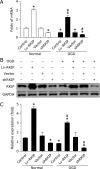Raf kinase inhibitor protein regulates oxygen-glucose deprivation-induced PC12 cells apoptosis through the NF-κB and ERK pathways
- PMID: 27698534
- PMCID: PMC5018566
- DOI: 10.3164/jcbn.15-128
Raf kinase inhibitor protein regulates oxygen-glucose deprivation-induced PC12 cells apoptosis through the NF-κB and ERK pathways
Abstract
Raf-1 kinase inhibitory protein (RKIP) is a critical molecule for cellular responses to stimuli. In this study, we investigated whether RKIP is responsible for neural cell apoptosis induced by oxygen-glucose deprivation (OGD) and explored the role of NF-κB and ERK pathways regulated by RKIP under OGD stimuli. RKIP was overexpressed or knocked down using lentivirus in PC12 cells, which were then challenged by OGD. RKIP overexpression significantly increased the cell viability of OGD cells, and attenuated apoptosis, cell cycle arrest, and reactive oxygen species generation. RKIP knockdown induced reverse effects. Moreover, we found that RKIP interacted with TAK1, NIK, IKK, and Raf-1 and negatively regulated the NF-κB and ERK pathways. RKIP overexpression significantly inhibited IKK, IκBα, and P65 phosphorylation in NF-κB pathway and MEK, ERK, and CREB phosphorylation in ERK pathway, respectively. RKIP knockdown induced reverse effects. Furthermore, a NF-κB inhibitor BAY 11-7082 and a MEK inhibitor U0126 blocked the changes caused by RKIP down-regulation after OGD. In conclusion, these results demonstrate that RKIP plays a key role in neural cell apoptosis caused by OGD partly via regulating NF-κB and ERK pathways. The present study may provide new insights into the role of RKIP in ischemic stroke.
Keywords: ERK pathway; NF-κB pathway; OGD; PC12 cells; RKIP.
Conflict of interest statement
No potential conflicts of interest were disclosed.
Figures





Similar articles
-
Raf Kinase Inhibitor Protein Attenuates Ischemic-Induced Microglia Cell Apoptosis and Activation Through NF-κB Pathway.Cell Physiol Biochem. 2017;41(3):1125-1134. doi: 10.1159/000464119. Epub 2017 Feb 28. Cell Physiol Biochem. 2017. PMID: 28245468
-
RKIP Regulates Neural Cell Apoptosis Induced by Exposure to Microwave Radiation Partly Through the MEK/ERK/CREB Pathway.Mol Neurobiol. 2015;51(3):1520-9. doi: 10.1007/s12035-014-8831-5. Epub 2014 Aug 10. Mol Neurobiol. 2015. PMID: 25108669
-
(-)-Epigallocatechin 3-gallate inhibits invasion by inducing the expression of Raf kinase inhibitor protein in AsPC‑1 human pancreatic adenocarcinoma cells through the modulation of histone deacetylase activity.Int J Oncol. 2013 Jan;42(1):349-58. doi: 10.3892/ijo.2012.1686. Epub 2012 Nov 6. Int J Oncol. 2013. PMID: 23135610
-
The activated NF-kappaB-Snail-RKIP circuitry in cancer regulates both the metastatic cascade and resistance to apoptosis by cytotoxic drugs.Crit Rev Immunol. 2009;29(3):241-54. doi: 10.1615/critrevimmunol.v29.i3.40. Crit Rev Immunol. 2009. PMID: 19538137 Review.
-
Raf-1 kinase inhibitor protein: structure, function, regulation of cell signaling, and pivotal role in apoptosis.Adv Cancer Res. 2004;91:169-200. doi: 10.1016/S0065-230X(04)91005-6. Adv Cancer Res. 2004. PMID: 15327891 Review.
Cited by
-
SEC-induced activation of ANXA7 GTPase suppresses prostate cancer metastasis.Cancer Lett. 2018 Mar 1;416:11-23. doi: 10.1016/j.canlet.2017.12.008. Epub 2017 Dec 13. Cancer Lett. 2018. PMID: 29247827 Free PMC article.
-
Progress in Pathological and Therapeutic Research of HIV-Related Neuropathic Pain.Cell Mol Neurobiol. 2023 Oct;43(7):3343-3373. doi: 10.1007/s10571-023-01389-7. Epub 2023 Jul 20. Cell Mol Neurobiol. 2023. PMID: 37470889 Free PMC article.
-
PEBP balances apoptosis and autophagy in whitefly upon arbovirus infection.Nat Commun. 2022 Feb 11;13(1):846. doi: 10.1038/s41467-022-28500-8. Nat Commun. 2022. PMID: 35149691 Free PMC article.
-
ERK1/2 Activity Is Critical for the Outcome of Ischemic Stroke.Int J Mol Sci. 2022 Jan 9;23(2):706. doi: 10.3390/ijms23020706. Int J Mol Sci. 2022. PMID: 35054890 Free PMC article.
References
-
- Mozaffarian D, Benjamin EJ, Go AS, et al. .; American Heart Association Statistics Committee and Stroke Statistics Subcommittee Heart disease and stroke statistics--2015 update: a report from the American Heart Association. Circulation. 2015;131:e29–e322. - PubMed
-
- Martin R, Lloyd H, Cowan A. The early events of oxygen and glucose deprivation: setting the scene for neuronal death? Trends Neurosci. 1994;17:251–257. - PubMed
-
- Sawe N, Steinberg G, Zhao H. Dual roles of the MAPK/ERK1/2 cell signaling pathway after stroke. J Neurosci Res. 2008;86:1659–1669. - PubMed
-
- Chen X, Chen S, Jiang Y, et al. Minocycline reduces oxygen–glucose deprivation-induced PC12 cell cytotoxicity via matrix metalloproteinase-9, integrin β1 and phosphorylated Akt modulation. Neurol Sci. 2013;34:1391–1396. - PubMed
LinkOut - more resources
Full Text Sources
Other Literature Sources
Research Materials
Miscellaneous

